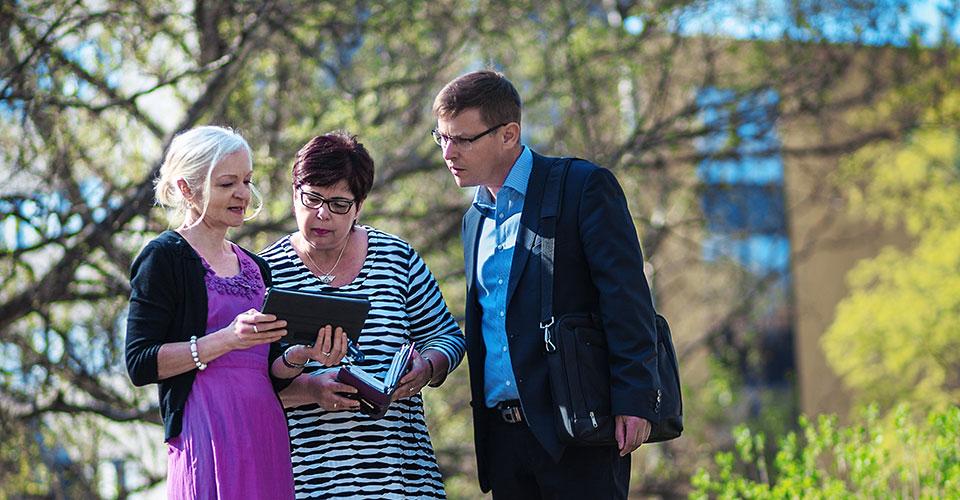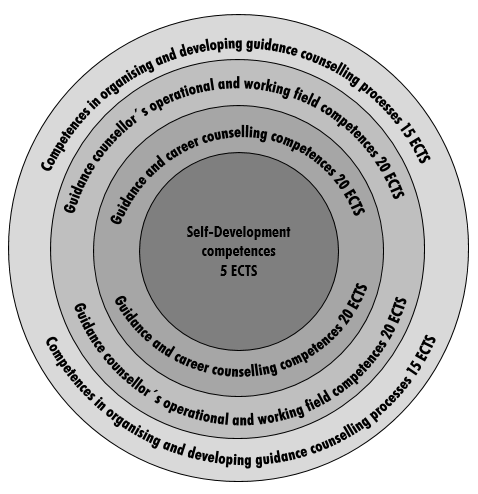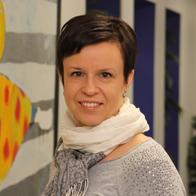
Vesa Parkkonen & Päivi Pukkila
Guidance and guidance counselling are in the process of change due to the phenomenon of digitalism in education. The pedagogical approach and methods in guidance and guidance counselling need updating. (Tait 1999, 113; Vuorinen 2006, 62.) This is due to the rapid change of customer expectations and needs in the field of guidance. Digitalisation provides new tools for guidance and guidance counselling. The current trend of using individual study paths in education can also be supported by different digital solutions. The guidance services can be provided through various channels. Digitalisation provides new tools for guidance and guidance counselling. (Iacob 2012, 7.) The current trend of using individual study paths in education can be supported by different digital solutions (Botnariuc 2012, 28). The role of ICT in guidance services has increased and thus has a wider range of digital tools, including social media and mobile technologies (Kettunen 2017, 23). The need and demand for creative thinking is ever present in guidance. Therefore, the guidance counsellor education must change in order to provide new knowledge and skills for future guidance counsellors.
HAMK University of Applied Sciences started an online, competence-based Guidance Counsellor Education Programme in 2016. The programme, in its own right, is very unique; it is the only online guidance counselling programme in Finland. The programme has been very popular among student applicants. Launching this online programme created vivid discussions among other actors of educational institutes and among people working in the field of guidance and guidance counselling. Concerns were expressed regarding the programme content and its pedagogical practices. In order to ensure the programme’s reliability, the programme was launched with a following assurance: a thorough research and investigation on the students’ learning processes, acquired skills and competencies will be conducted.
In our research and investigation, we conducted a feedback survey and interviewed the graduating students, asking them to analyse and describe their own learning processes. Finally, the entire HAMK Guidance Counsellor Online Education Programme has been critically analysed and recommendations for further developing the programme have been put into practice.
Objectives
HAMK University of Applied Sciences started an online, competence-based Guidance Counsellor Education Programme in 2016. The programme, in its own right, is very unique; it is the only online guidance counselling programme in Finland. The programme has been very popular among student applicants. In 2016, only five percent of the applicants were able to get into the programme. The launching of this online programme created vivid discussions among the other actors of educational institutes and among people working in the field of guidance and guidance counselling. Concerns have been expressed regarding the programme content and its pedagogical practices. Thus, there has been a lot of debate on delivering guidance counselling services online. (Goss & Hooley 2015, 1; Bimrose, Kettunen & Goddard 2015, 8.) For instance, several people in the Finnish social media declared that guidance and guidance counselling are disciplines that require regular student gatherings and physical presence in order to establish authentic dialogue and interaction. In order to ensure the programme’s reliability, the programme was launched with the following assurance: a thorough research and investigation on the students’ learning processes, acquired skills and competencies will be conducted.
Approaches
The structure of the HAMK Guidance Counsellor Online Education Programme consists of four modules which reflect the core competence areas in guidance and guidance counselling. The modules are as follows: Self-development competences; Guidance and career counselling competences; Guidance counsellor’s operational and working field competences and Competences in organising and developing guidance counselling processes. The learning outcomes of the guidance counsellor education programme are based on the definitions by international guidance and counselling organisation IAEVG (IAEVG 2016). In addition, the definitions are based on the definitions of the European career guidance research network (Schiersmann, Ertelt, Katsarov, Mulvey, Reid & Weber 2012, 53–55).

Main objective of the programme is to support the students to build a strong competence identity as a guidance counsellor. Furthermore, to provide the students with professional skills in guidance, career guidance and guidance counselling. In the centre of the learning are the individual learning paths and the principles of sharing one’s skills and knowledge with peer students and teachers. The use of a variety of digital tools is highly encouraged and recommended throughout the course of the programme. Each student is responsible for building up his/her own personal learning environment (PLE).
Each year, fourteen students are chosen for the Guidance Counsellor Online Education Programme. The programme starts with a two-day contact learning period in the facilities of the organising education provider. After the initial contact learning period, the programme is carried out with a total of ten online meetings which take place about once a month within 13 months. Between the online meetings, the students complete various exercises and assignments such as work placement. As the programme progresses, the responsible teachers meet their guidance counsellor students twice in study circles to watch videotaped guidance sessions. In addition, the responsible teachers meet each student once in their respective places of work.
In the beginning of the Guidance Counsellor Online Education Programme, students fill out a HOK (mapping of personal competence) form to map out personal competence for reflecting on their own competence related to the different modules of the guidance counsellor education programme. After filling out the form, each responsible teacher has a personal online guidance discussion with each student to map out the student’s competence and possible recognition of prior learning (RPL). Based on the guidance discussion, the student constructs an individual study path and a personal study plan. During the programme, the student makes a personal digital portfolio where they reflect on their learning (Barns, Clark & Thull 2003, 3). The aim is to use the individual study paths to build a strong competence identity in guidance counselling for each student (Vieno, Helander & Saari, 2017). The students always have the right to receive personal guidance if they so wish.
The work in online meetings is based on building constructive knowledge, skill and competence. The responsible teachers send students an invitation to an online meeting and give instructions for necessary exercises and tools. Flipped classroom and learning enable an effective learning event. The sessions revolve around the students, each taking turns to speak. Lectures and other materials have been uploaded online to support students’ learning.
Methods and results
For the research, fourteen graduating online students were sent a survey which was taken by ten students. The graduation survey was supplemented with two individual interviews. The survey used a 5-level Likert scale (1 = “very poorly”, 5 = “very well”). The programme was evaluated with seventeen statements. Based on the average values of the graduation survey, it can be stated that, in the students’ opinion, the Guidance Counsellor Online Education Programme has promoted and developed their guidance competence in all areas of the programme. The results of the graduation survey are presented in the following table.
To supplement the graduation survey, we interviewed two students who graduated from the programme. The interviews were recorded. The following questions were asked: motivation for applying to the HAMK Guidance Counsellor Online Education Programme; personal learning (acquired knowledge, skills and competencies); digital skills (variety of tools); application of digitalisation in guidance; needs for study support during the course of the study programme (e.g. peer support, teacher support). All responses supported the information produced by the graduation survey. Both programme graduates felt that the Guidance Counsellor Online Education Programme was a meaningful way of studying and that their guidance counsellor competence had increased during the programme significantly.
Conclusions
The Guidance Counsellor Online Education Programme has been a successful experiment. The programme has been extremely popular, and in 2018, nearly half of the applicants primarily applied for the online education programme.
Both teachers of the Guidance Counsellor Online Education Programme have worked in multiform education for ten years. Starting the online programme was seen as a new and worthwhile challenge. When planning the programme, a central idea was that the online implementation and digital nature would support and enable guidance counsellor education. Students are guaranteed the same learning and increase of competence in both multiform and online professional guidance counsellor education. Both teachers felt that the online option is a practical way of learning the profession of guidance counsellor. As the process progresses, the teachers have observed and learned greatly. The online meetings need to be planned carefully to stay on schedule. Opportunities to speak must be divided equally, and students must be able to be succinct. Also, online guidance must be provided at regular intervals, and the significance of giving feedback is highlighted.
Finally, the entire HAMK Guidance Counsellor Online Education Programme has been critically analysed and recommendations for developing the programme further has been put into practice.
Authors

MSc (Business Administration), MA (Vocational Education) Vesa Parkkonen is a Senior Lecturer in Häme University of Applied Sciences (HAMK). He is specialised in guidance of learning / study and career counseling, individualization of learning / individual learning paths, internationalization of vocational education, global education, marketing of educational institutions, and entrepreneurship education.

Päivi Pukkila, ME, is a Senior Lecturer in Häme University of Applied Sciences (HAMK). She is specialised in guidance of learning / study and career counseling, individualization of learning / individual learning paths and interprofessional teamwork in counseling services.
References
Barnes, P. E., Clark, P. A. & Thull, B. (2003). Web-based digital portfolios and counsellor supervision. Counseling Faculty Publications, Paper 1. University of Nebraska at Omaha.
Bimrose, J., Kettunen, J. & Goddard, T. (2015). ICT – the new frontier? Pushing the boundaries of career practice. British Journal of Guidance & Counselling, 43(1), 8–23. Retrieved 17 May 2018 from http://dx.doi.org/10.1080/03069885.2014.975677
Botnariuc, P. (2012). ICT skills: An integrated framework for delivering the ICT competence of guidance counsellors. In M. Iacob (Ed.), Good practices in the use of ICT in providing guidance and counselling. Bucharest: Institute of Educational Sciences, 25–32. Retrieved 16 March 2018 from http://www.jobtribu.eu/pdf/JT_ICT_Goodpractices_web.pdf
Goss, S. & Hooley, T. (2015). Symposium on online practice in counselling and guidance. British Journal of Guidance & Counselling, 43(1), 1–7. Retrieved 17 May 2018 from https://doi.org/10.1080/03069885.2015.995471
Iacob, M. (2012). The use of ICT in delivering counselling services: a Europe wide survey. In M. Iacob (Ed.), Good practices in the use of ICT in providing guidance and counselling. Bucharest: Institute of Educational Sciences, 7–4. Retrieved 2018 March 16 from http://www.jobtribu.eu/pdf/JT_ICT_Goodpractices_web.pdf
IAEVG (2016). International Association for Educational and Vocational Guidance. Retrieved 17 May 2018 from iaevg.net
Kettunen, J. (2017). Career practitioners’ conceptions of social media and competency for social media in career services. Doctoral thesis, University of Jyväskylä, Finnish Institute for Educational Research Studies 32. Retrieved 16 March 2018 from https://jyx.jyu.fi/dspace/bitstream/handle/123456789/55367/978-951-39-7160-1.pdf
Schiersmann, C., Ertelt, B.-J., Katsarov, J., Mulvey, R., Reid, H., &
Weberhe, P. (Eds.) (2012). NICE Handbook for the Academic Training of Career Guidance and Counselling Professionals. Retrieved 17 March 2018 from http://www.eunec.eu/sites/www.eunec.eu/files/members/attachments/handbook_for_the_academic_trainingoof_guidance_and_counselling_professionals.pdf
Tait, Alan. (1999). Face-to-face and at a distance: The mediation of guidance and counselling through the new technologies. British Journal of Guidance & Counselling 27(1), 113–122. Retrieved 17 May 2018 from https://doi.org/10.1080/03069889908259719
Vieno, A., Helander, J., & Saari, J. (2017). Osaamisperusteisuudesta osaamisidentiteettiin. HAMK Unlimited Journal. Retrieved 17 March 2018 from https://unlimited.hamk.fi/ammatillinen-osaaminen-ja-opetus/osaamisperusteisuudesta-osaamisidentiteettiin
Vuorinen, R. (2006). Internet ohjauksessa vai ohjaus internetissä? [The Internet in guidance or guidance in the Internet? Perceptions of guidance practitioners on the use of the Internet as a tool in guidance]. (Research Report 19. Jyväskylä, Finland: University of Jyväskylä, Institute for Educational Research.) Retrieved 17 March 2018 from https://jyx.jyu.fi/dspace/bitstream/handle/123456789/37756/T019.pdf





